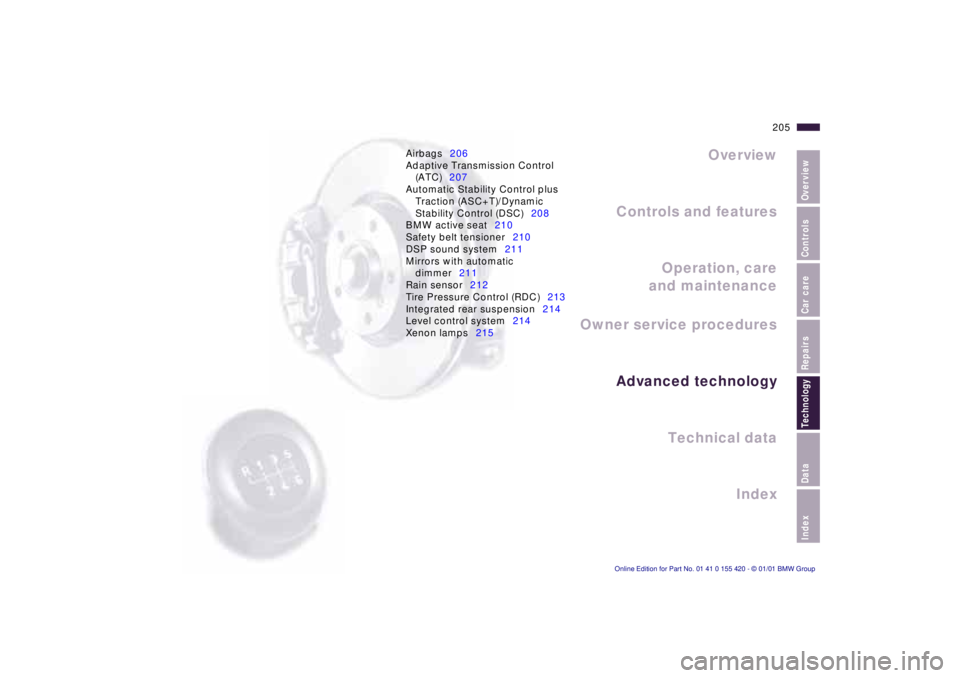2001 BMW SPORT WAGON traction control
[x] Cancel search: traction controlPage 140 of 238

140nBreak-in procedure
To ensure that your vehicle provides
maximum economy throughout a long
service life, we request that you ob-
serve the following.
Engine and differential
Up to 1,200 miles (2,000 km):
Drive at varying engine speeds and
road speeds, but do not exceed
4,500 rpm and the following road
speeds during this initial period:
BMW 525i, 530i: 100 mph (160 km/h)
BMW 540i: 106 mph (170 km/h)
Obey your local and state maximum
speed limits.
Refrain from using full throttle and avoid
pressing the accelerator beyond the
kickdown point.
Once you have driven 1,200 miles
(2,000 km), engine and vehicle speeds
can gradually be increased.
You should also comply with these
break-in procedures if the engine or dif-
ferential is replaced later in the course
of the vehicle service life.
Tires
Due to technical factors associated
with their manufacture, tires do not
achieve their full traction potential until
an initial break-in period has elapsed
for this reason, drive with extra care
during the initial 200 miles (300 km).
Obey your local and state maximum
speed limits.
When the vehicle is operated on
wet or slushy roads, a wedge of
water may form between the tire and
the road surface. This phenomenon is
referred to as aquaplaning, or hydro-
planing, and can lead to partial or com-
plete loss of traction, vehicle control
and braking effectiveness. Reduce your
speed on wet roads. <
Brake system
Approximately 300 miles (500 km) must
elapse before the brake pads and ro-
tors achieve the optimal pad-surface
and wear patterns required for trouble-
free operation and long service life later
on.
To break in the separate parking brake
drums, apply the parking brake lightly
when coasting to a standstill (at a traffic
signal, for instance), provided that traf-
fic conditions allow you to do so. To
avoid corrosion, repeat this procedure
from time to time.
The brake lamps do not come on
when the parking brake is applied.
Vacuum for the brake system servo unit
on your BMW is available only when the
engine is running. When you move the
car with the engine shut off – when
towing, for instance – substantially
higher levels of pedal force will be
required to brake the vehicle. <
Clutch
The clutch will also begin to function
optimally after about 300 miles
(500 km). Engage the gears carefully
during the break-in period.
Page 143 of 238

Index
Data
Technology
Repairs
Car care
Controls
Overview
143nAntilock Brake System (ABS)
The concept
ABS enhances active safety by helping
to prevent the wheels from locking un-
der braking. The reason: locked wheels
are dangerous, because the vehicle
cannot be steered when the front
wheels slip, and loss of traction at the
rear wheels can cause the rear end to
break into an uncontrolled skid.
ABS is designed to meet two essential
requirements during every brake appli-
cation:
>To help provide vehicle stability.
> To help retain steering and maneu-
vering capability on all types of road
surface (asphalt, concrete, dirt,
moisture, snow and ice).
With ABS, the shortest possible braking
distances are achieved under most
conditions (on straight-aways and in
curves, with different road surfaces).
Braking with ABS
The system becomes operative once
the vehicle exceeds a speed of approx.
6 mph (10 km/h). The ABS is deacti-
vated whenever the vehicle's speed
drops back below approx. 4 mph
(6 km/h). This means that the wheels
can lock in the final phase of a brake
application – a factor of no significance
in actual use.
The ABS system works best in situa-
tions requiring maximum pressure on
the pedal (full braking). Since the vehi-
cle maintains steering responsiveness,
you can nevertheless avoid possible
obstacles with a minimum of steering
effort.
The ABS closed-loop control circuit cy-
cles in fractions of a second. A pulsing
of the brake pedal, combined with the
sounds associated with the hydraulic
controls, tells you that the brake system
is within its maximum limit range and
reminds you that you should adapt your
vehicle's speed to road conditions. On road surfaces which have a loose
layer on a firm base (on gravel or snow,
for instance), the braking distances with
ABS may be longer than with the
wheels locked. This also applies to
driving with snow chains. However,
ABS continues to provide enhanced
vehicle stability and steering response
under these conditions.
Page 147 of 238

Index
Data
Technology
Repairs
Car care
Controls
Overview
147nWinter operation
Rubber seals and components
In order to prevent the weather-strip-
ping from freezing, apply BMW rubber
treatment or silicone spray to the seals
on the doors, hood and luggage com-
partment lid/tailgate.
A full range of car-care products is
available from your BMW center. <
Snow chains
BMW snow chains* can be mounted on
both summer and winter tires. Mount
them in pairs on the rear wheels only
and comply with the manufacturer's
safety precautions. Do not exceed a
maximum speed of 30 mph (50 km/h).
For maximum traction, we recommend
that you manually deactivate the
ASC+T/DSC
* when driving with snow
chains mounted. Refer to page 102.
Starting off
We recommend that you use the
manual control switch to deactivate
ASC+T/ DSC
* when starting off in deep
snow or when rocking the car to free it
(refer to page 102).
Driving on low-traction road
surfaces
Use smooth, gentle pressure to control
the accelerator pedal. Avoid excessive
engine speeds and shift to the next
higher gear at an early point. Adapt
your speed and driving style when ap-
proaching grades or slopes. Maintain
an adequate distance between yourself
and the vehicle ahead.
Brakes
Winter road conditions substantially
reduce the amount of traction available
between the tires and the road surface.
The resulting increases in braking dis-
tance are considerable and should be
kept in mind at all times.
ABS is intended to prevent the wheels
from locking during brake applications,
thus helping to maintain vehicle stability
and steering response. If the ABS does not respond in a critical
braking situation and the wheels lock:
reduce the pressure on the brake pedal
until the wheels just start to roll again
while still maintaining enough force to
continue braking.
Following that, increase pedal pressure
again. Reduce the pressure as the
wheels lock, then reapply pressure.
Repeat this procedure.
This type of staggered braking will
reduce the braking distance, and the
vehicle still remains responsive to
steering.
You can then attempt to steer around
hazards after you have reduced pres-
sure on the brake pedal.
Do not shift down on slick road
surfaces. Doing so could cause
the rear wheels to lose traction and
skid, which could result in the loss of
vehicle control. <
Depress the clutch during hard
braking on road surfaces which
provide only poor or uneven traction. <
Page 151 of 238

Index
Data
Technology
Repairs
Car care
Controls
Overview
151nTire replacement
To maintain good handling and vehicle
response, use only tires of a single
tread configuration from a single manu-
facturer. BMW tests and approves
wheel/tire combinations. Refer to
page 153.
DOT Quality Grades
Treadwear
Traction AA A B C
Temperature A B C
All passenger car tires must con-
form to Federal Safety Require-
ments in addition to these grades. <
Treadwear
The treadwear grade is a comparative
rating based on the wear rate of the tire
when tested under controlled condi-
tions on a specified government test
course.
For example, a tire graded 150 would
wear one and one-half (1g) times as
well on the government course as a tire
graded 100. The relative performance
of tires depends upon the actual condi-
tions of their use, however, and may
depart significantly from the norm due
to variations in driving habits, service
practices and differences in road char-
acteristics and climate.
Traction
The traction grades, from highest to
lowest, are AA, A, B and C.
Those grades represent the tire's ability
to stop on wet pavement as measured
under controlled conditions on speci-
fied government test surfaces of as-
phalt and concrete. A tire marked C
may have poor traction performance.
The traction grade assigned to
this tire is based on straight-
ahead braking traction tests, and does
not include acceleration, cornering, hy-
droplaning, or peak traction character-
istics. <
Temperature
The temperature grades are A (the
highest), B and C, representing the
tire's resistance to the generation of
heat and its ability to dissipate heat
when tested under controlled condi-
tions on a specified indoor laboratory
test wheel.
Sustained high temperature can cause
the material of the tire to degenerate
and reduce tire life, and excessive tem-
perature can lead to sudden tire failure.
The grade C corresponds to a level of
performance which all passenger car
tires must meet under the Federal Mo-
tor Vehicle Safety Standard No. 109.
Grades B and A represent higher levels
of performance on the laboratory test
wheel than the minimum required by
law.
The temperature grade for this tire
is established for a tire that is
properly inflated and not overloaded.
Excessive speed, underinflation, or ex-
cessive loading, either separately or in
combination, can cause heat buildup
and possible tire failure. <
Page 205 of 238

Index
Data
Technology
Repairs
Car care
Controls
Overview
Overview
Controls and features Operation, care
and maintenance
Owner service procedures
Technical dataIndex
Advanced technology
205
n
Airbags 206
Adaptive Transmission Control (ATC) 207
Automatic Stability Control plus Traction (ASC+T)/Dynamic
Stability Control (DSC) 208
BMW active seat 210
Safety belt tensioner 210
DSP sound system 211
Mirrors with automatic dimmer 211
Rain sensor 212
Tire Pressure Control (RDC) 213
Integrated rear suspension 214
Level control system 214
Xenon lamps 215
Page 228 of 238

Everything from A to Z
A
ABS (Antilock Brake
System)23, 143
Accessories6
Activated-charcoal
filter119
Active seat55, 210
Adaptive Transmission
Control (ATC)72, 207
Add
antifreeze168
t
brake fluid168
t
engine coolant168
t
engine oil165
t
washer fluids164
t
Adjust washer
nozzles164
t
Adjusting
backrest angle53
backrest, forward/
backward52
seats52
steering wheel56
temperature110, 116
thigh support55
Air conditioner108
Air distribution110, 116
Air outlets108, 114
Air pressure29
t
, 150
t
Air supply110, 117
Air vent108, 114Airbags23, 62, 176, 206
Alarm system47
Antennas149
Antifreeze167
t
radiator146
Antilock Brake System
(ABS)23, 143
Anti-theft alarm system47
Anti-theft protection39
Approved axle weight221
Approved gross vehicle
weight221
Approved roof load
capacity221
Aquaplaning141, 150
Arrival time97
ASC+T/DSC (Automatic
Stability Control plus
Traction/Dynamic Stability
Control)24, 102, 208
Ashtray126
ATC (Adaptive Transmission
Control)72, 207
Attach vacuum cleaner127
AUC (Automatic
recirculated-air
control)117
Automatic car washes171
Automatic climate
control114
remove condensation from
windows117Automatic cruise control81
Automatic curb monitor59
Automatic dimming
interior rearview mirror57
Automatic rear window
cleaning80
Automatic recirculated-air
control (AUC)117
Automatic Stability Control
plus Traction/Dynamic
Stability Control (ASC+T/
DSC)24, 102, 208
Automatic transmission72
Automatic transmission with
Steptronic75
Average fuel
consumption89
Average speed89, 98
Avoid false alarms48
t
Axle loads221
B
Backrest, adjusting52, 55
Backup lamps71
bulb replacement186
t
Battery193
t
, 224
capacity224
charge condition194
t
charging194
discharged200
t
removing and
installing195
t
Belts61
Beverage holder125
Blower110, 117
BMW active seat55, 210
BMW comfort seat54
BMW sports seat55
BMW Universal
Transmitter121
Body-cavity protectant172
Brake faults146
t
Brake hydraulic
system22, 146
Brake lamps, bulb
replacement186
t
Brake system140
brake faults146
brake fluid168
brake lamps, bulb
replacement186
brake pads23
disc brakes144
parking brake23, 70
Brake-in procedure140
Break-resistant security
glass174
care174
t
Bulb replacement183
t
C
California Proposition
65 Warning177
Capacity223
Page 234 of 238

Everything from A to Zroll-up cover132
securing a load136
ski bag131
tail lamp assembly, bulb
replacement186t
tailgate, manual release
after electrical fault198t
Sports seat55
Sports steering wheel26
Start the engine69
Starting69
Starting assistance200t
Starting help200
Starting off147
Starting problems
69, 142t, 200t
Starting the engine68t
Steel wheel158
Steering148
Steering wheel
adjustment56
heating120
lock68
memory58
Steptronic75
Stopwatch93
Storage124
Summer tires153
Sun blind cover120
Sun visors57Sunroof50
with glass moonroof51
Switching off the engine69
Switch-on times
input94
Symbols4
TTachometer84
Tail lamp assembly, bulb
replacement186t
Tail lamps186
Tailgate199
convenience opening
mode40
manual release after
electrical fault199
refer also to luggage
compartment
release after an electrical
defect199t
Tank capacity223
Technical
modifications6, 177
Telephone hookup125
Temperature display, engine
coolant85
Temperature display,
outside temperature83
Temperature gauge85
Temperature
layering111, 119Tensioning straps46
Thigh support
adjustment55
Third brake lamp, bulb
replacement187t
Through-loading
system128
Tilt alarm40
Tilt alarm sensor48
deactivation48
Tilt function
passenger side exterior
mirror59
steering wheel56
Time
calling up92
changing92
of arrival, estimated97
Tire
change190
code153
damage150
inflation pressure30, 150
monitoring inflation
pressure103, 213
renewal151
rotation between
axles151
tread150
valve caps154
wear indicator150Tire Pressure Control
(RDC)103, 213
Tire, changing190t
Tools182t
Torque218
Tow fittings201t
Towing201t
Tow-starting201t
Track width219
Traction control system,
refer to ASC+T/DSC
Transmission70, 75
Transmitter key36
Transporting children
safely66
Tread depth indicators150
Tread depth, tires150
Tread wear indicator150
Trip odometer83
Trunk, refer to luggage
compartment
Turn signal indicator78
bulb replace-
ment184t, 186t
Turning circle219
UUniform Tire Quality Grading
(UTQR)152
Universal Transmitter121
Use antifreeze167t